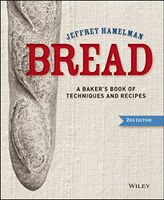Advertisement
Preparation info
- Dough Yield: About
17
loaves at 2 lb each - Difficulty
Medium
Appears in
Published 2004
The following three formulas are presented as a comparison of the results obtained when rye bread is made with a sourdough containing rye flour, with a sourdough containing white flour, and with no sourdough at all. Note that the first and second formulas are naturally leavened, and the only differences between them are that the first formula has a slightly higher hydration and it is leavened with rye sourdough, and a firm white levain leavens the second formula. The third formula relies on


